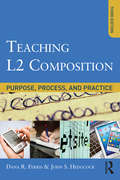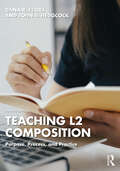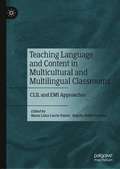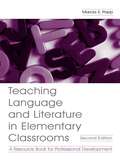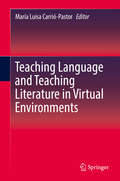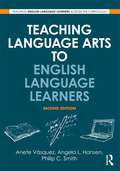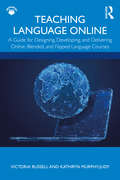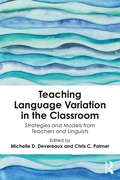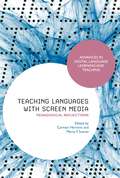- Table View
- List View
Teaching L2 Composition: Purpose, Process, and Practice
by Dana R. Ferris John HedgcockThis popular, comprehensive theory-to-practice text is designed to help teachers understand the task of writing, L2 writers, the different pedagogical models used in current composition teaching, and reading–writing connections. Moving from general themes to specific pedagogical concerns, it includes practice-oriented chapters on the role of genre, task construction, course and lesson design, writing assessment, feedback, error treatment, and classroom language (grammar, vocabulary, style) instruction. Although all topics are firmly grounded in relevant research, a distinguishing feature of the text is the array of hands-on, practical examples, materials, and tasks that pre- and in-service teachers can use to develop the complex skills involved in teaching second language writing. Each chapter includes Questions for Reflection, Further Reading and Resources, Reflection and Review, and Application Activities. An ideal text for L2 teacher preparation courses, courses that include both L1 and L2 students, and workshops for instructors of L2 writers in academic (secondary and postsecondary) settings, the accessible synthesis of theory and research enables readers to see the relevance of the field’s knowledge base to their own present or future classroom settings and student writers.
Teaching L2 Composition: Purpose, Process, and Practice
by Dana R. Ferris John HedgcockThis popular, comprehensive theory-to-practice text is designed to help teachers understand the task of writing, L2 writers, the different pedagogical models used in current composition teaching, and reading–writing connections. Moving from general themes to specific pedagogical concerns, it includes practice-oriented chapters on the role of genre, task construction, course and lesson design, writing assessment, feedback, error treatment, and classroom language (grammar, vocabulary, style) instruction. Although all topics are firmly grounded in relevant research, a distinguishing feature of the text is the array of hands-on, practical examples, materials, and tasks that pre- and in-service teachers can use to develop the complex skills involved in teaching second language writing. Each chapter includes Questions for Reflection, Further Reading and Resources, Reflection and Review, and Application Activities. An ideal text for L2 teacher preparation courses, courses that include both L1 and L2 students, and workshops for instructors of L2 writers in academic (secondary and postsecondary) settings, the accessible synthesis of theory and research enables readers to see the relevance of the field’s knowledge base to their own present or future classroom settings and student writers.
Teaching L2 Composition: Purpose, Process, and Practice
by Dana R. Ferris John S. HedgcockThis popular, comprehensive theory-to-practice text helps teachers understand the task of writing, L2 writers, the different pedagogical models used in current composition teaching, and reading-writing connections. Moving from general themes to specific pedagogical concerns, it includes practice-oriented chapters on the role of genre, task construction, course and lesson design, writing assessment, feedback, error treatment, and classroom language (grammar, vocabulary, style) instruction. Each chapter includes Questions for Reflection, Further Reading and Resources, Reflection and Review, and Application Activities. An ideal text for L2 teacher preparation courses and in-service writing instructors, the text offers an accessible synthesis of theory and research that enables readers to see the relevance of the field’s knowledge base to their own present or future classroom settings and student writers. New to the Fourth Edition: Updated with new research, theory, and developments in the field throughout the text Visually accessible layout and design for improved reader navigability Expanded attention to technological affordances for writing pedagogy Stand-alone reference list in each chapter Support Material with activities and resources from the text also available on the book’s webpage at www.routledge.com/9780367436780
Teaching L2 Composition: Purpose, Process, and Practice
by Dana R. Ferris John S. HedgcockThis popular, comprehensive theory-to-practice text helps teachers understand the task of writing, L2 writers, the different pedagogical models used in current composition teaching, and reading-writing connections. Moving from general themes to specific pedagogical concerns, it includes practice-oriented chapters on the role of genre, task construction, course and lesson design, writing assessment, feedback, error treatment, and classroom language (grammar, vocabulary, style) instruction. Each chapter includes Questions for Reflection, Further Reading and Resources, Reflection and Review, and Application Activities. An ideal text for L2 teacher preparation courses and in-service writing instructors, the text offers an accessible synthesis of theory and research that enables readers to see the relevance of the field’s knowledge base to their own present or future classroom settings and student writers. New to the Fourth Edition: Updated with new research, theory, and developments in the field throughout the text Visually accessible layout and design for improved reader navigability Expanded attention to technological affordances for writing pedagogy Stand-alone reference list in each chapter Support Material with activities and resources from the text also available on the book’s webpage at www.routledge.com/9780367436780
Teaching Language and Content in Multicultural and Multilingual Classrooms: CLIL and EMI Approaches
by María Luisa Carrió-Pastor Begoña Bellés-FortuñoThis edited book explores critical issues relating to Content and Language Integrated Learning (CLIL) and English as a Medium of Instruction (EMI), setting out their similarities and differences to demystify the terms and their implications for classroom practice. The authors show how CLIL and EMI practices are carried out in different institutional contexts and demonstrate how both approaches can benefit language and content acquisition. This book is addressed to second/foreign language teaching staff involved in teaching in English at primary education, secondary education, and higher education levels.
Teaching Language and Literacy in the Early Years
by Diane Godwin Margaret PerkinsThe early years are increasingly recognized as a priority time for the education of children and language and literacy are key elements of any early childhood program. This second edition provides an accessible text on the current research and thinking surrounding these areas and demonstrates clearly how this theory can work in practice. The authors provide guidance on planning, assessment and recording; suggest appropriate activities, resources and play ideas to help those who work with or are planning to work within the foundation stage. The second edition includes specific reference to both the curriculum guidance for the Foundation Curriculum and the framework of teaching objectives for the National Literacy Strategy and puts these within a framework which acknowledges the centrality of play and talk in the early years. The book is firmly grounded in the requirements of the Foundation curriculum and is a suitable textbook for undergraduate early childhood courses, all those following routes into early years teaching, and existing practitioners in all types of early years settings. The book will also be appropriate reading for LEA advisers and those who inspect early years settings.
Teaching Language and Literacy in the Early Years
by Diane Godwin Margaret PerkinsThe early years are increasingly recognized as a priority time for the education of children and language and literacy are key elements of any early childhood program. This second edition provides an accessible text on the current research and thinking surrounding these areas and demonstrates clearly how this theory can work in practice. The authors provide guidance on planning, assessment and recording; suggest appropriate activities, resources and play ideas to help those who work with or are planning to work within the foundation stage. The second edition includes specific reference to both the curriculum guidance for the Foundation Curriculum and the framework of teaching objectives for the National Literacy Strategy and puts these within a framework which acknowledges the centrality of play and talk in the early years. The book is firmly grounded in the requirements of the Foundation curriculum and is a suitable textbook for undergraduate early childhood courses, all those following routes into early years teaching, and existing practitioners in all types of early years settings. The book will also be appropriate reading for LEA advisers and those who inspect early years settings.
Teaching Language and Literature in Elementary Classrooms: A Resource Book for Professional Development
by Marcia S. PoppThe goal of this book -- a theoretically based, well-organized, useful guide for teaching -- is to help the beginning teacher create a classroom environment that integrates literacy development with learning in all areas of the curriculum. The major components of an integrated language program are identified, and the skills teachers need to implement this kind of program in their own classrooms are described. Designed to be kept and used as a resource in the classroom, this text provides fundamental information about language arts teaching. A constructivist orientation, an emphasis on teachers as reflective decision makers, and vivid portrayals of the classroom as a community of learners and inquirers are woven throughout the book. Key features include: * a wealth of models, suggestions, and step-by-step guidelines for introducing integrated teaching and learning practices into elementary classrooms at the kindergarten, primary, and intermediate levels; * a focus on relevant research in language arts and professional teacher development; * true-to-life classroom narratives that model instructional strategies and demonstrate interactions between real teachers and students; and * an innovative chapter format that makes the text accessible as a resource for student, beginning, and experienced teachers.
Teaching Language and Literature in Elementary Classrooms: A Resource Book for Professional Development
by Marcia S. PoppThe goal of this book -- a theoretically based, well-organized, useful guide for teaching -- is to help the beginning teacher create a classroom environment that integrates literacy development with learning in all areas of the curriculum. The major components of an integrated language program are identified, and the skills teachers need to implement this kind of program in their own classrooms are described. Designed to be kept and used as a resource in the classroom, this text provides fundamental information about language arts teaching. A constructivist orientation, an emphasis on teachers as reflective decision makers, and vivid portrayals of the classroom as a community of learners and inquirers are woven throughout the book. Key features include: * a wealth of models, suggestions, and step-by-step guidelines for introducing integrated teaching and learning practices into elementary classrooms at the kindergarten, primary, and intermediate levels; * a focus on relevant research in language arts and professional teacher development; * true-to-life classroom narratives that model instructional strategies and demonstrate interactions between real teachers and students; and * an innovative chapter format that makes the text accessible as a resource for student, beginning, and experienced teachers.
Teaching Language and Teaching Literature in Virtual Environments
by María Luisa Carrió-PastorThis book sheds new light on language and literature teaching, and offers examples of teaching language in virtual environments. Providing an overview of virtual environments for teaching, it also includes chapters devoted to methodology design for second language teaching in these environments. Further it describes tools for second/ foreign language teaching and proposals for specific second language teaching in virtual environments. Lastly, it presents experiments on literature teaching in virtual environments and discusses the future of technology in education. With interdisciplinary appeal, the book is a particularly valuable resource for scholars with an interest in technology, language teaching and literature teaching.
Teaching Language Arts in Middle Schools: Connecting and Communicating
by Sharon KingenThis text is designed specifically to meet the needs of preservice teachers who have had little experience working in middle-grade classrooms. Three ideas are central: * teaching language arts at the middle level is a complex activity that demands expertise in the use of a variety of strategies, * reading and writing are key processes of language arts study, but so are speaking, listening, and viewing/visually representing, and * teaching the processes of effective communication is crucial, but middle school students must also begin to learn the content of the field--literature, language, and media. Teaching Language Arts in Middle Schools gives balanced attention to various teaching strategies, processes, and content, demonstrating how all of these connect to improve students' abilities to communicate. In this text: *Research and theory are summarized and applied to practice *A non-prescriptive approach is integrated with practical information *Debates in the field are acknowledged *Additional reading and research are emphasized *The author's voice and point of view are explicit
Teaching Language Arts in Middle Schools: Connecting and Communicating
by Sharon KingenThis text is designed specifically to meet the needs of preservice teachers who have had little experience working in middle-grade classrooms. Three ideas are central: * teaching language arts at the middle level is a complex activity that demands expertise in the use of a variety of strategies, * reading and writing are key processes of language arts study, but so are speaking, listening, and viewing/visually representing, and * teaching the processes of effective communication is crucial, but middle school students must also begin to learn the content of the field--literature, language, and media. Teaching Language Arts in Middle Schools gives balanced attention to various teaching strategies, processes, and content, demonstrating how all of these connect to improve students' abilities to communicate. In this text: *Research and theory are summarized and applied to practice *A non-prescriptive approach is integrated with practical information *Debates in the field are acknowledged *Additional reading and research are emphasized *The author's voice and point of view are explicit
Teaching Language Arts to English Language Learners
by Anete Vásquez Angela L. Hansen Philip C. SmithThis thoroughly revised and updated edition of Teaching Language Arts to English Language Learners provides readers with the comprehensive understanding of both the challenges that face ELLs and ways in which educators might address them in the language arts classroom. The authors offer proven techniques that teachers can readily use to teach reading, writing, grammar, and vocabulary as well as speaking, listening, and viewing skills. A complete section is also devoted to ways teachers can integrate all five strands of the language arts curriculum into a comprehensive unit of study with meaningful accommodations for ELLs. An annotated list of web and print resources completes the volume, making this a valuable reference for language arts teachers to meet the challenges of including all learners in effective instruction. New features to this edition include: An updated and streamlined Part 1, which provides an essential overview of ELL theory in a language arts specific context. Additional practical examples of language arts exercises, all of which are closely aligned with the Common Core State Standards. New pedagogical elements in Part 3, including tips on harnessing new technologies, discussion questions and reflection points. Updates to the web and print resources in Part 4
Teaching Language Arts to English Language Learners
by Anete Vásquez Angela L. Hansen Philip C. SmithThis thoroughly revised and updated edition of Teaching Language Arts to English Language Learners provides readers with the comprehensive understanding of both the challenges that face ELLs and ways in which educators might address them in the language arts classroom. The authors offer proven techniques that teachers can readily use to teach reading, writing, grammar, and vocabulary as well as speaking, listening, and viewing skills. A complete section is also devoted to ways teachers can integrate all five strands of the language arts curriculum into a comprehensive unit of study with meaningful accommodations for ELLs. An annotated list of web and print resources completes the volume, making this a valuable reference for language arts teachers to meet the challenges of including all learners in effective instruction. New features to this edition include: An updated and streamlined Part 1, which provides an essential overview of ELL theory in a language arts specific context. Additional practical examples of language arts exercises, all of which are closely aligned with the Common Core State Standards. New pedagogical elements in Part 3, including tips on harnessing new technologies, discussion questions and reflection points. Updates to the web and print resources in Part 4
Teaching Language as Action in the ELA Classroom
by Richard Beach Faythe BeaucheminThis book explores English language arts instruction from the perspective of language as "social actions" that students and teachers enact with and toward one another to create supportive, trusting relations between students and teachers, and among students as peers. Departing from a code-based view of language as a set of systems or structures, the perspective of languaging as social actions takes up language as emotive, embodied, and inseparable from the intellectual life of the classroom. Through extensive classroom examples, the book demonstrates how elementary and secondary ELA teachers can apply a languaging perspective. Beach and Beauchemin employ pedagogical cases and activities to illustrate how to enhance students’ engagement in open-ended discussions, responses to literature, writing for audiences, drama activities, and online interactions. The authors also offer methods for fostering students' self-reflection to improve their sense of agency associated with enhancing relations in face-to-face, rhetorical, and online contexts.
Teaching Language as Action in the ELA Classroom
by Richard Beach Faythe BeaucheminThis book explores English language arts instruction from the perspective of language as "social actions" that students and teachers enact with and toward one another to create supportive, trusting relations between students and teachers, and among students as peers. Departing from a code-based view of language as a set of systems or structures, the perspective of languaging as social actions takes up language as emotive, embodied, and inseparable from the intellectual life of the classroom. Through extensive classroom examples, the book demonstrates how elementary and secondary ELA teachers can apply a languaging perspective. Beach and Beauchemin employ pedagogical cases and activities to illustrate how to enhance students’ engagement in open-ended discussions, responses to literature, writing for audiences, drama activities, and online interactions. The authors also offer methods for fostering students' self-reflection to improve their sense of agency associated with enhancing relations in face-to-face, rhetorical, and online contexts.
Teaching Language Online: A Guide for Designing, Developing, and Delivering Online, Blended, and Flipped Language Courses
by Victoria Russell Kathryn Murphy-JudyPractical and accessible, this book comprehensively covers everything you need to know to design, develop, and deliver successful online, blended, and flipped language courses. Grounded in the principles of instructional design and communicative language teaching, this book serves as a compendium of best practices, research, and strategies for creating learner-centered online language instruction that builds students’ proficiency within meaningful cultural contexts. This book addresses important topics such as finding and optimizing online resources and materials, learner engagement, teacher and student satisfaction and connectedness, professional development, and online language assessment. Teaching Language Online features: A step-by-step guide aligned with the American Council on the Teaching of Foreign Languages (ACTFL), the Common European Framework of Reference (CEFR) for Languages: Learning, Teaching and Assessment, and the World-Class Instructional Design and Assessment (WIDA) standards Research-based best practices and tools to implement effective communicative language teaching (CLT) online Strategies and practices that apply equally to world languages and ESL/EFL contexts Key takeaway summaries, discussion questions, and suggestions for further reading in every chapter Free, downloadable eResources with further readings and more materials available at www.routledge.com/ 9781138387003 As the demand for language courses in online or blended formats grows, K-16 instructors urgently need resources to effectively transition their teaching online. Designed to help world language instructors, professors, and K-12 language educators regardless of their level of experience with online learning, this book walks through the steps to move from the traditional classroom format to effective, successful online teaching environments.
Teaching Language Online: A Guide for Designing, Developing, and Delivering Online, Blended, and Flipped Language Courses
by Victoria Russell Kathryn Murphy-JudyPractical and accessible, this book comprehensively covers everything you need to know to design, develop, and deliver successful online, blended, and flipped language courses. Grounded in the principles of instructional design and communicative language teaching, this book serves as a compendium of best practices, research, and strategies for creating learner-centered online language instruction that builds students’ proficiency within meaningful cultural contexts. This book addresses important topics such as finding and optimizing online resources and materials, learner engagement, teacher and student satisfaction and connectedness, professional development, and online language assessment. Teaching Language Online features: A step-by-step guide aligned with the American Council on the Teaching of Foreign Languages (ACTFL), the Common European Framework of Reference (CEFR) for Languages: Learning, Teaching and Assessment, and the World-Class Instructional Design and Assessment (WIDA) standards Research-based best practices and tools to implement effective communicative language teaching (CLT) online Strategies and practices that apply equally to world languages and ESL/EFL contexts Key takeaway summaries, discussion questions, and suggestions for further reading in every chapter Free, downloadable eResources with further readings and more materials available at www.routledge.com/ 9781138387003 As the demand for language courses in online or blended formats grows, K-16 instructors urgently need resources to effectively transition their teaching online. Designed to help world language instructors, professors, and K-12 language educators regardless of their level of experience with online learning, this book walks through the steps to move from the traditional classroom format to effective, successful online teaching environments.
Teaching Language Variation in the Classroom: Strategies and Models from Teachers and Linguists
by Michelle D. Devereaux Chris C. PalmerBringing together the varied and multifaceted expertise of teachers and linguists in one accessible volume, this book presents practical tools, grounded in cutting-edge research, for teaching about language and language diversity in the ELA classroom. By demonstrating practical ways teachers can implement research-driven linguistic concepts in their own teaching environment, each chapter offers real-world lessons as well as clear methods for instructing students on the diversity of language. Written for pre-service and in-service teachers, this book includes easy-to-use lesson plans, pedagogical strategies and activities, as well as a wealth of resources carefully designed to optimize student comprehension of language variation.
Teaching Language Variation in the Classroom: Strategies and Models from Teachers and Linguists
by Michelle D. Devereaux Chris C. PalmerBringing together the varied and multifaceted expertise of teachers and linguists in one accessible volume, this book presents practical tools, grounded in cutting-edge research, for teaching about language and language diversity in the ELA classroom. By demonstrating practical ways teachers can implement research-driven linguistic concepts in their own teaching environment, each chapter offers real-world lessons as well as clear methods for instructing students on the diversity of language. Written for pre-service and in-service teachers, this book includes easy-to-use lesson plans, pedagogical strategies and activities, as well as a wealth of resources carefully designed to optimize student comprehension of language variation.
Teaching Languages To Students With Specific Learning Differences (MM Textbooks #18)
by Judit Kormos Anne Margaret SmithThis book is intended to help language teachers to work effectively and successfully with students who have Specific Learning Differences (SpLDs). It enables teachers to gain a thorough understanding of the nature of SpLDs and how these affect both general learning processes and the mechanisms of second language acquisition. In addition, the book explores the particular inclusive methods and techniques of teaching and assessment that foster success in language learning. Language teaching is embedded in a wider social and educational context, and therefore the book also provides an in-depth discussion of general educational issues related to identifying and disclosing disabilities and to making transitions from one institution to the other. The content has been thoroughly updated and revised for the second edition, particularly in the areas of inclusive pedagogies, new evidence-based methods and tools for identifying SpLDs, and new conceptualisations of neurodiversity. The book also includes the latest research on assessment, transition and progression, and the impact of SpLDs on additional language learning.
Teaching Languages To Students With Specific Learning Differences (Mm Textbooks #8)
by Judit Kormos Anne Margaret SmithThis book is intended to help language teachers to work effectively and successfully with students who have specific learning differences (SpLD) such as dyslexia. The book takes an inclusive and practical approach to language teaching and encourages teachers to consider the effects that an SpLD could have on a language learner. It suggests strategies that can be implemented to enable learners to succeed both in the classroom and in formal assessment. The book places issues of language teaching for learners with an SpLD in a broad educational context and, in addition to practical advice on methodologies and classroom management, also discusses discourses of the field, the identification of SpLDs and facilitating progression.
Teaching Languages To Young Learners (PDF)
by Lynne CameronRecent years have seen rapid growth in the numbers of children being taught foreign languages at younger ages. While course books aimed at young learners are appearing on the market, there is scant theoretical reference in the teacher education literature. Teaching Languages to Young Learners is one of the few to develop readers' understanding of what happens in classrooms where children are being taught a foreign language. It will offer teachers and trainers a coherent theoretical framework to structure thinking about children's language learning. It gives practical advice on how to analyse and evaluate classroom activities, language use and language development. Examples from classrooms in Europe and Asia will help bring alive the realities of working with young learners of English.
Teaching Languages with Screen Media: Pedagogical Reflections (Advances in Digital Language Learning and Teaching)
by Carmen Herrero and Marta F. SuarezIn recent years, the expansion of screen media, including film, TV, music videos, and computer games, has inspired new tools for both educators and learners. This book illustrates how screen media can be exploited to support foreign language (L2) teaching and learning.Drawing on a range of theories and approaches from second language acquisition, audio-visual translation, multimodality, and new media and film studies, this book provides both best practices and in-depth research on this interdisciplinary field. Areas of screen media-enhanced learning and teaching are covered across 4 sections: film and broadcast media, in-depth case studies, translation and screen media, and interactive media. With a focus on pedagogical approaches to teaching and learning Spanish, French, German, and English as a Foreign Language, Teaching Languages with Screen Media presents innovative insights in this new interdisciplinary field.
Teaching Languages with Screen Media: Pedagogical Reflections (Advances in Digital Language Learning and Teaching)
In recent years, the expansion of screen media, including film, TV, music videos, and computer games, has inspired new tools for both educators and learners. This book illustrates how screen media can be exploited to support foreign language (L2) teaching and learning.Drawing on a range of theories and approaches from second language acquisition, audio-visual translation, multimodality, and new media and film studies, this book provides both best practices and in-depth research on this interdisciplinary field. Areas of screen media-enhanced learning and teaching are covered across 4 sections: film and broadcast media, in-depth case studies, translation and screen media, and interactive media. With a focus on pedagogical approaches to teaching and learning Spanish, French, German, and English as a Foreign Language, Teaching Languages with Screen Media presents innovative insights in this new interdisciplinary field.
